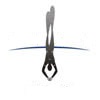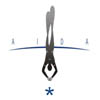
AIDA
Monofin Freediver
LAUFEND NEUE KURSE
Kontakt über
info@apnoevision.ch
zu Reservationen/Kursbeginn/Ort
International Association for the Development of Apnea
Association Internationale pour le Développement de l'Apnée -
version 2009-v1.0,
COPYRIGHT © AIDA INTERNATIONAL 2007
AIDA
Monofin
Freediver
Course Outline
PREREQUISITES
To enrol in the AIDA Monofin Freediver course, an individual must:
•
Be 18 years of age or older (16 years with parent or guardian
consent)
• Have completed the AIDA ** Freediver course/ AIDA ** Pool
Freediver course
or equivalent
• Have completed the AIDA Medical Form
• Have completed the Liability Release
COURSE PURPOSE
The AIDA Monofin Freediver course is designed to be an introduction
to monofin swiming and to help the student develop the basic skills,
techniques and knowledge necessary to start using the monofin
efficiently.
Students will be introduced to different approaches to freediving
with a monofin, exercises designed to work on style and how to
design a training program.
The course may include one session in Open Water.
To conduct an AIDA Monofin Freediver course, the following knowledge
development and water sessions are to be included:
KNOWLEDGE DEVELOPMENT
The knowledge development will take place in a classroom-like
environment.
A minimum of 1 theory session should be taught and this should be a
minimum duration of 1 ½ hours.
AIDA Instructors may supplement this information with any updated
information such as recent developments in freedive knowledge and
information specific to freediving in the local area. You may find
it useful to have other reference books handy such as an anatomy
atlas, freedive DVDs, magazine articles or reference books.
This theory session(s) will include:
•
History of the monofin, origins of finswimming, crossover into
freediving
• Monofin construction and design, current manufacturers and how to
choose
and fit your fin
• How to care for and transport your monofin safely
• Freediving categories which use the monofin, the differences
needed in blade
and technique and the advantages and disadvantages of monofins over
bi-fins
• Equipment for use with the monofin and how it differs from other
freediving
equipment, to include short fins, front snorkel and use of a float
• Dry training to develop the body for monofin freediving
• Physiology for monofin freediving. The physiological differences
between
dynamic and constant weight freediving with a monofin
• Key rules to remember for monofin freediving safely
• Sources of further information
CONFINED WATER SESSIONS
This course may be conducted at any swimming pool or confined water
site although it is recommended the pool be at least 25 metres long.
Dynamic dives should be conducted in water divided into lanes and
preferably over a line on the bottom that can be used as a point of
reference by the student.
If the second session is an OW session, the dive should be conducted
with a line
to be used as a point of reference by the student freediver. This
line should be sufficiently buoyed and weighted so that the student
freediver could use it to pull either up or down if necessary. The
line should be at least 8mm in diameter and the bottom plate should
be no deeper than 20m. All dives should be conducted with the
supervision of the instructor.
When the training takes place in water with less than 10m
visibility, strong current, or in water deeper than the depth at
which the bottom plate is positioned, a lanyard should be used for
all dives except those where the student is acting as a safety
freediver. Students should always have access to a float, pool-side
or other meansof support on surfacing.
Confined Water Session One
After this session the student freediver will be able to:
• Perform a stretching routine suitable for preparing the body for a
monofin
freediving session
• Demonstrate the monofin technique in a standing position on land
• Perform apnea swims using small bi fins for a maximum distance of
25m,
to practice the monofin style
• Perform apnea swims using the monofin for a maximum distance of
25m,
to practice the monofin style
Confined Water Session Two or OW session
After this session the student freediver will be able to:
• Keep practicing the monofin style in the pool or in OW doing CW
dives
• Demonstrate rescue procedures using a monofin, for a monofin
freediver who
experiences a black out underwater. This will include lifting the monofin
freediver
to the surface from the bottom of the pool or from 5-8m in OW and
performing
correct rescue procedures once on the surface
• Maintain a static and upright position in the water for at least
two minutes
• Design a personal technique drill for further training with the
help of the
instructor
EQUIPMENT
Student Equipment –
mask, monofin, short bi fins, snorkel, appropriate exposure
protection, weightbelt, lanyard (if appropriate)
Instructor Equipment –
mask, monofin, front snorkel, appropriate exposure protection,
weightbelt, stop watch, depth gauge, first aid kit, oxygen
administration kit (in countries where this is permitted or required
by local law) guideline with bottom plate, lanyard and floatation
device (if appropriate)
Optional Equipment –nose
clip, goggles, lights, underwater video camera
INSTRUCTOR SUPERVISION
The AIDA Monofin Freediver course may be conducted by an Active AIDA
Instructor with current CPR and First Aid training (completed within
the last two years). The instructor should carry liability insurance
for teaching freediving.
The maximum student diver-to-instructor ratio for open water
training dives is four students per instructor (4:1). This may rise
to six students per instructor (6:1) when the instructor is assisted
by another freediver qualified to at least AIDA **** level. The
maximum student diver-to-instructor ratio in confined water is eight
students per instructor (8:1). With an AIDA ****Freediver acting as
an Assistant, 4 additional students may be added to this ratio to a
maximum of 12 students
ADMINISTRATION AND PAPERWORK
Before commencing any in-water training, each student freediver must
complete the following documents, for students aged under 18 years,
both must be co-signed by a parent or guardian:
•
AIDA Medical Statement – this must be completed in full with
students marking
YES or NO to each of the medical conditions listed. If the student
answers YES
to any condition, they must seek medical approval before taking part in
any in-
water activity. The physician must sign the form to indicate this
approval.
Whether or not the student then is then accepted onto the course is left
at the
discretion of the instructor.
• AIDA Liability Release or local equivalent
The AIDA Instructor should hold these documents on file for a
minimum of seven years or longer if required by local legislation.
CERTIFICATION PROCEDURES
Freedivers who meet all the performance requirements outlined above
may be certified as an AIDA Monofin Freediver. The certification
request should mot be send later than 3 month from the certification
date.
KEY STANDARDS
Prerequisite certifications: AIDA ** or **Pool Freediver or
equivalent
Minimum Age: 18 or older (16 with parent/guardian signature)
Minimum theory sessions: 1 of at least 1 ½ hours
Minimum confined water sessions: 2
The course should be run over at least 1 days
Student to Instructor Training: 8:1 (confined water),12:1 (confined
water with an assistant of certified to least AIDA ****Freediver),
4:1 (open water) ) 6:1 (open water with an assistant of certified to
least AIDA ****Freediver)
Minimum Instructor Rating: AIDA Instructor, Active with current
First Aid and CPR Training (within 2 years)
AIDA Freediver Kurse
 APNOE
Basis
Freediver
APNOE
Basis
Freediver
 AIDA *Freediver
AIDA *Freediver
 AIDA **Freediver
AIDA **Freediver
 AIDA ***Freediver
AIDA ***Freediver
 AIDA ****Freediver
AIDA ****Freediver
AIDA Instructor Kurse
 AIDA Instructor
AIDA Instructor
 AIDA Master Instructor
AIDA Master Instructor
 AIDA Instructor Trainer
AIDA Instructor Trainer
AIDA Spezial
Kurse
 APNOE Coaching & Training WK
APNOE Coaching & Training WK
 AIDA
Monofin-Freediver
AIDA
Monofin-Freediver
 AIDA Competiton
Freediver
AIDA Competiton
Freediver
 AIDA Deep Tank Freediver
AIDA Deep Tank Freediver
 AIDA
Competition Safety Freediver
AIDA
Competition Safety Freediver
AIDA Mental Kurse
.jpg) Entspannungs-/
Mentaltraining
Entspannungs-/
Mentaltraining
zurück zu Kurslevels



 AIDA *Freediver
AIDA *Freediver AIDA **Freediver
AIDA **Freediver AIDA ***Freediver
AIDA ***Freediver AIDA ****Freediver
AIDA ****Freediver

 AIDA Competiton
Freediver
AIDA Competiton
Freediver

.jpg) Entspannungs-/
Mentaltraining
Entspannungs-/
Mentaltraining